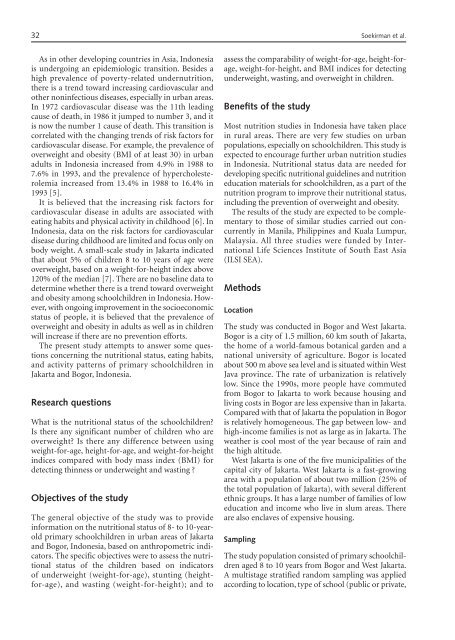F&N Bulletin Vol 23 No 1b - United Nations University
F&N Bulletin Vol 23 No 1b - United Nations University
F&N Bulletin Vol 23 No 1b - United Nations University
Create successful ePaper yourself
Turn your PDF publications into a flip-book with our unique Google optimized e-Paper software.
32<br />
Soekirman et al.<br />
As in other developing countries in Asia, Indonesia<br />
is undergoing an epidemiologic transition. Besides a<br />
high prevalence of poverty-related undernutrition,<br />
there is a trend toward increasing cardiovascular and<br />
other noninfectious diseases, especially in urban areas.<br />
In 1972 cardiovascular disease was the 11th leading<br />
cause of death, in 1986 it jumped to number 3, and it<br />
is now the number 1 cause of death. This transition is<br />
correlated with the changing trends of risk factors for<br />
cardiovascular disease. For example, the prevalence of<br />
overweight and obesity (BMI of at least 30) in urban<br />
adults in Indonesia increased from 4.9% in 1988 to<br />
7.6% in 1993, and the prevalence of hypercholesterolemia<br />
increased from 13.4% in 1988 to 16.4% in<br />
1993 [5].<br />
It is believed that the increasing risk factors for<br />
cardiovascular disease in adults are associated with<br />
eating habits and physical activity in childhood [6]. In<br />
Indonesia, data on the risk factors for cardiovascular<br />
disease during childhood are limited and focus only on<br />
body weight. A small-scale study in Jakarta indicated<br />
that about 5% of children 8 to 10 years of age were<br />
overweight, based on a weight-for-height index above<br />
120% of the median [7]. There are no baseline data to<br />
determine whether there is a trend toward overweight<br />
and obesity among schoolchildren in Indonesia. However,<br />
with ongoing improvement in the socioeconomic<br />
status of people, it is believed that the prevalence of<br />
overweight and obesity in adults as well as in children<br />
will increase if there are no prevention efforts.<br />
The present study attempts to answer some questions<br />
concerning the nutritional status, eating habits,<br />
and activity patterns of primary schoolchildren in<br />
Jakarta and Bogor, Indonesia.<br />
Research questions<br />
What is the nutritional status of the schoolchildren?<br />
Is there any significant number of children who are<br />
overweight? Is there any difference between using<br />
weight-for-age, height-for-age, and weight-for-height<br />
indices compared with body mass index (BMI) for<br />
detecting thinness or underweight and wasting ?<br />
Objectives of the study<br />
The general objective of the study was to provide<br />
information on the nutritional status of 8- to 10-yearold<br />
primary schoolchildren in urban areas of Jakarta<br />
and Bogor, Indonesia, based on anthropometric indicators.<br />
The specific objectives were to assess the nutritional<br />
status of the children based on indicators<br />
of underweight (weight-for-age), stunting (heightfor-age),<br />
and wasting (weight-for-height); and to<br />
assess the comparability of weight-for-age, height-forage,<br />
weight-for-height, and BMI indices for detecting<br />
underweight, wasting, and overweight in children.<br />
Benefits of the study<br />
Most nutrition studies in Indonesia have taken place<br />
in rural areas. There are very few studies on urban<br />
populations, especially on schoolchildren. This study is<br />
expected to encourage further urban nutrition studies<br />
in Indonesia. Nutritional status data are needed for<br />
developing specific nutritional guidelines and nutrition<br />
education materials for schoolchildren, as a part of the<br />
nutrition program to improve their nutritional status,<br />
including the prevention of overweight and obesity.<br />
The results of the study are expected to be complementary<br />
to those of similar studies carried out concurrently<br />
in Manila, Philippines and Kuala Lumpur,<br />
Malaysia. All three studies were funded by International<br />
Life Sciences Institute of South East Asia<br />
(ILSI SEA).<br />
Methods<br />
Location<br />
The study was conducted in Bogor and West Jakarta.<br />
Bogor is a city of 1.5 million, 60 km south of Jakarta,<br />
the home of a world-famous botanical garden and a<br />
national university of agriculture. Bogor is located<br />
about 500 m above sea level and is situated within West<br />
Java province. The rate of urbanization is relatively<br />
low. Since the 1990s, more people have commuted<br />
from Bogor to Jakarta to work because housing and<br />
living costs in Bogor are less expensive than in Jakarta.<br />
Compared with that of Jakarta the population in Bogor<br />
is relatively homogeneous. The gap between low- and<br />
high-income families is not as large as in Jakarta. The<br />
weather is cool most of the year because of rain and<br />
the high altitude.<br />
West Jakarta is one of the five municipalities of the<br />
capital city of Jakarta. West Jakarta is a fast-growing<br />
area with a population of about two million (25% of<br />
the total population of Jakarta), with several different<br />
ethnic groups. It has a large number of families of low<br />
education and income who live in slum areas. There<br />
are also enclaves of expensive housing.<br />
Sampling<br />
The study population consisted of primary schoolchildren<br />
aged 8 to 10 years from Bogor and West Jakarta.<br />
A multistage stratified random sampling was applied<br />
according to location, type of school (public or private,
















